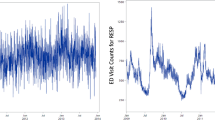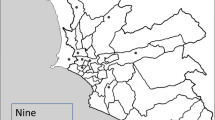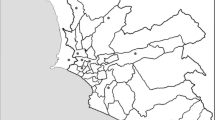Abstract
A limitation of most air pollution health effects studies is that they rely on monitoring data averaged over one or more ambient monitors to represent daily air pollution exposures for individuals. Such data analyses therefore implicitly require the assumption of a homogeneous spatial distribution for particulate matter (PM). This assumption may be suspected in the Pacific Northwest because of its hilly topography and local variations in wood burning. To examine the bias from substituting regional PM (i.e., the average of three ambient monitor measurements) for individual PM exposure, we conducted an exposure substudy to identify the influence of location factors, specifically urban versus suburban classification and topographic features (“upstream” versus “downstream”), on local ambient measurements. Using nephelometer measurements collected over 1 year in four locations, we developed regression models to predict local PM as a function of regional PM, atmospheric stagnation, temperature, and location. We found a significant interaction between atmospheric stagnation and topography, with the most upstream site having reduced PM levels on high stagnation days after controlling for regional PM. We also found a significant interaction with temperature at one downstream site thought to be heavily exposed to wood smoke in the winter. These results are consistent with the physics of surface radiation inversions. The interactions reordered the index versus referent exposures in a case–crossover analysis of out-of-hospital primary cardiac arrest for subjects living in specific locations, but did not meaningfully change the associations with PM from the analysis using regional PM as the exposure. The lack of change in these results may be due to limitations in the data used to correct the exposure estimates or to the absence of a PM effect among persons without prior heart disease who experienced a primary cardiac arrest.
This is a preview of subscription content, access via your institution
Access options
Subscribe to this journal
Receive 6 print issues and online access
$259.00 per year
only $43.17 per issue
Buy this article
- Purchase on Springer Link
- Instant access to full article PDF
Prices may be subject to local taxes which are calculated during checkout



Similar content being viewed by others
References
Anusewski J et al Simultaneous indoor and outdoor particle light scattering measurements at nine homes using a portable nephelometer. J. Expos. Anal. Environ. Epidemiol. (1998) 8: 483–493
Beven K, and Kirkby MJ, A physically based, variable contributing area of basin hydrology. Hydrol. Sci. Bull. (1979) 24: 43–69
Larson T et al Urban air toxics mitigation study, phase 1. Technical Report, Puget Sound Air Pollution Control Agency, Seattle, Washington (1989
Larson T et al Weekly composite sampling of PM2.5 for total mass and trace elements analysis. In: Chow J. (Ed.), Transactions of the Specialty Conference on PM10 Standards and Non-Traditional Particle Source ControlsAir and Waste Management Association, Pittsburgh, PA 1992 pp.39–50
Levy D, Sheppard L, Checkoway H, Kaufman J, Lumley T, Koenig J, and Siscovick D, A case–crossover analysis of fine particulate matter air pollution and out-of-hospital sudden cardiac arrest. Epidemiology (2001a) 12 (in press)
Levy D, Lumley T, Sheppard L, Kaufman J, and Checkoway H, Referent selection in case–crossover analyses of acute health effects of air pollution. Epidemiology (2001b) 12 (in press)
Liang KY and Liu XH, Estimating equations in generalized linear models with measurement error, Chap. 4. In: Godambe V.P. (Ed.), Estimating Functions. Oxford University Press, Oxford 1991 pp.47–63
Lumley T, and Levy D, Bias in the case–crossover design: implications for studies of air pollution. Environmetrics (2000) 11: 689–704
Mage DT et al, Assessment of human exposure to ambient particulate matter. J. Air Waste Manage. Assoc. (1999) 49: 1280–1291
Moore ID et al, Hydrologic characteristics and modeling of a small, forested catchment in southeastern New South Wales: prelogging condition. J. Hydrol. (1986) 83: 307–335
Norris G, Larson T, Koenig J, Claiborn C, Sheppard L, and Finn D, Asthma aggravation, combustion, and stagnant air. Thorax (2000) 55: 466–470
O'Loughlin EM, Prediction of surface saturation zones in natural catchments by topographic analysis. Water Resour. Res. (1986) 22: 794–804
Stardata, Qualitative Marketing Software, Inc., Dallas, Texas, (1997)
Sheppard L, and Damian D, Environmetrics (2000) 11: 675–687
Sheppard L, Levy D, Norris G, Larson T, and Koenig J, Effects of ambient air pollution on non-elderly asthma hospital admissions in Seattle, Washington, 1987–1994. Epidemiology (1999) 10: 23–30
Siscovick DS Raghunathan TE King I Weinmann S, Wicklund KG Albright J Bovbjerg V Arbogast P Smith H Kushi LH et al, Dietary intake and cell membrane levels of long-chain n−3 polyunsaturated fatty acids and the risk of primary cardiac arrest. JAMA (1995) 274: 1363–1367
Acknowledgements
We thank David Montgomery and Harvey Greenberg from the Department of Geology at the University of Washington for their assistance with the TI calculations. We also thank Timothy Larson from the Department of Civil Engineering at the University of Washington for helpful discussions on the physics of inversions. This research was funded, in part, by contract no. 97-2-2 from the Health Effects Institute and grant ES08062-03 from the National Institute of Environmental Health Sciences, NIH. The contents are solely the responsibility of the authors and do not necessarily represent the official views of HEI or NIEHS.
Author information
Authors and Affiliations
Corresponding author
Rights and permissions
About this article
Cite this article
SHEPPARD, L., LEVY, D. & CHECKOWAY, H. Correcting for the effects of location and atmospheric conditions on air pollution exposures in a case–crossover study. J Expo Sci Environ Epidemiol 11, 86–96 (2001). https://doi.org/10.1038/sj.jea.7500151
Received:
Accepted:
Published:
Issue Date:
DOI: https://doi.org/10.1038/sj.jea.7500151
Keywords
This article is cited by
-
A study of PM2.5 and PM10 concentrations in the atmosphere of large cities in Gansu Province, China, in summer period
Journal of Earth System Science (2016)



